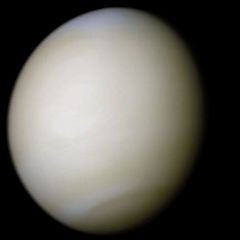Venus

Venus is the second-closest planet to the Sun, orbiting it every 224.7 Earth days. It is the brightest natural object in the night sky, except for the Moon, reaching an apparent magnitude of −4.6. Because Venus is an inferior planet from Earth, it never appears to venture far from the Sun: its elongation reaches a maximum of 47.8°. Venus reaches its maximum brightness shortly before sunrise or shortly after sunset, for which reason it is often called the Morning Star or the Evening Star.
Classified as a terrestrial planet, it is sometimes called Earth's "sister planet", because the two are similar in size, gravity, and bulk composition. Venus is covered with an opaque layer of highly reflective clouds of sulfuric acid, preventing its surface from being seen from space in visible light; this was a subject of great speculation until some of its secrets were revealed by planetary science in the twentieth century. Venus has the densest atmosphere of all the terrestrial planets, consisting mostly of carbon dioxide, as it has no carbon cycle to lock carbon back into rocks and surface features, nor organic life to absorb it in biomass. It has become so hot that the earth-like oceans that the young Venus is believed to have possessed have totally evaporated, leaving a dusty dry desertscape with many slab-like rocks. The best hypothesis is that the evaporated water vapor has dissociated, and with the lack of a planetary magnetic field, the hydrogen has been swept into interplanetary space by the solar wind. The atmospheric pressure at the planet's surface is 92 times that of the Earth.
Venus's surface has been mapped in detail only in the last 22 years, by Project Magellan. It shows evidence of extensive volcanism, and the sulfur in the atmosphere is taken by some experts to show that there has been some recent volcanism, but it is an enigma as to why no evidence of lava flow accompanies any of the visible caldera. It is also noteworthy that there are a surprisingly low number of impact craters. This demonstrates that the surface is relatively young, approximately half a billion years old. There is no evidence for plate tectonics, possibly because its crust is too strong to subduct without water to make it less viscous, and some suggest that instead Venus loses its internal heat in periodic massive resurfacing events.
